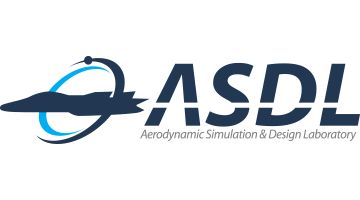Numerical methods for multi-phase flow simulations
In a broad sense, the term “multi-phase flows” refers to the flows of multi-species (ex. air) as well as the multi-phase flows of single species (ex. liquid water and water vapor). Computations on compressible multi-phase flows have been carried out in a wide range of disciplines for decades but are still challenging to perform due to the physical complexity intrinsic to multi-phase flows. Numerical methods, originally developed for single-phase gas dynamics, struggle to deal with such complex phenomena: the creation and evolution of another discontinuity (phase interface) besides a shock. In ASDL, a series of numerical methods for computing multi-phase flows have been actively developed based on the homogeneous mixture model.
Robust flux schemes for gas dynamics developed in ASDL have been extended to multi-phase flows (AUSMPW+_N, RoeM_N). These flux schemes are designed to resolve the convergence degradation problem caused by the large disparity in speed of sound between liquid and gas phases. Moreover, the AUSMPW+_N and RoeM_N scheme, which replace the conventional ideal gas assumption with a general relation, can be applied to the real fluid simulations.
Robust flux schemes for gas dynamics developed in ASDL have been extended to multi-phase flows (AUSMPW+_N, RoeM_N). These flux schemes are designed to resolve the convergence degradation problem caused by the large disparity in speed of sound between liquid and gas phases. Moreover, the AUSMPW+_N and RoeM_N scheme, which replace the conventional ideal gas assumption with a general relation, can be applied to the real fluid simulations.

Fig. 1. Density contours of Quirk’s test
The above figure shows the results of Quirk’s odd-even decoupling test in two-phase situation (gas mass fraction=0.1). With a subtle disturbance of grid, the numerical error is increased by the Roe’s FDS as the shock propagates, and thus, the original planar shock profile is destroyed. Both AUSMPW+_N and RoeM_N, however, capture the monotonic shock profile and remain stable throughout the simulation. Even when the mass fraction of gas phase varies, they always give stable results.

Fig. 2. Interaction between shock and water column :
(left, middle) pressure @ 7.2, 14.2 μs, (right) numerical Schlieren @ 96 μs
(left, middle) pressure @ 7.2, 14.2 μs, (right) numerical Schlieren @ 96 μs
The above figure is the result of interaction between shock in air and water column. Roe’s FDS is unable to compute this problem, but the flux schemes developed in ASDL successfully capture the detailed wave patterns. The AUSMPW+_N and RoeM_N are capable of simulating the complex problem of phase interface and shock wave interaction without difficulty.
Numerical methods for multi-phase flows should be suitable for the real fluid simulations, considering the wide application areas and various types of working fluid therein. In ASDL, phase change problems are studied by accurately reflecting the properties of the real fluid. The figure below presents the cavitation of cryogenic fluid (liquid nitrogen) around a hydrofoil. As the speed of sound decreases in the cavity, a supersonic region of Mach number one or greater appears.

Fig. 3. Cryogenic cavitation: (left) density, (right) Mach number
It is well-known that the diffuse interface methods including the homogenous mixture model have difficulty in maintaining sharp representation of phase interface for a long time. In order to cope with this defect, we are developing an interface-sharpening technique. Figure 4 shows the result of a three-component flow, where a shock in air passes the helium bubble and the water column consecutively. The helium bubble is highly deformed as the shock passes, and completely fractured as it flows along the water column. The shape of the helium is hardly recognizable in the figures on the left column. On the other hand, the helium interface remains sharp with the interface-sharpening technique developed in ASDL in the figures on the right column.

Fig. 4. Interaction between shock in air-helium bubble-water column:
(left) without, (right) with interface-sharpening technique
(left) without, (right) with interface-sharpening technique






